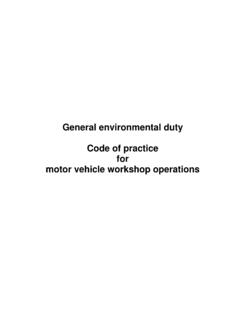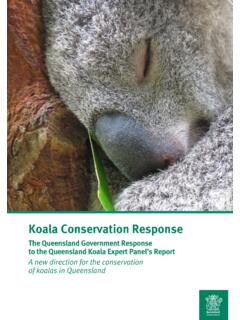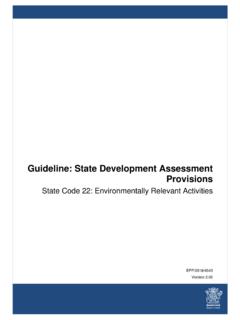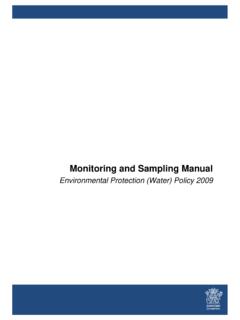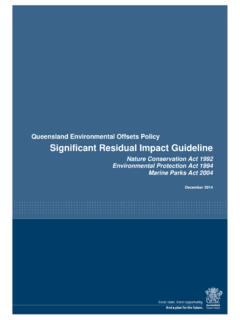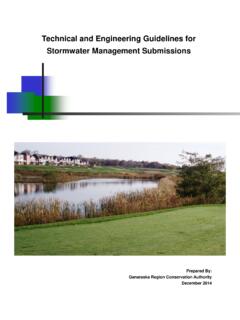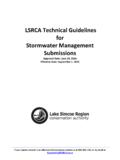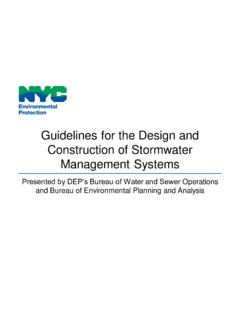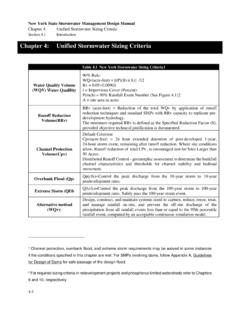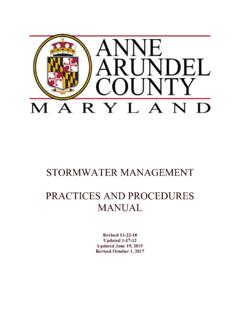Transcription of ESR/2015/1653 Stormwater guideline - Environmentally ...
1 guideline Stormwater and Environmentally relevant activities guideline Stormwater and Environmentally relevant activities Prepared by: Environmental Services and Environmental Regulatory Practice (non-Mining), Department of Environment and Science State of Queensland, 2014. The Queensland Government supports and encourages the dissemination and exchange of its information. The copyright in this publication is licensed under a Creative Commons Attribution Australia (CC BY) licence. Under this licence you are free, without having to seek our permission, to use this publication in accordance with the licence terms. You must keep intact the copyright notice and attribute the State of Queensland as the source of the publication. For more information on this licence, visit Disclaimer This document has been prepared with all due diligence and care, based on the best available information at the time of publication.
2 The department holds no responsibility for any errors or omissions within this document. Any decisions made by other parties based on this document are solely the responsibility of those parties. If you need to access this document in a language other than English, please call the Translating and Interpreting Service (TIS. National) on 131 450 and ask them to telephone Library Services on +61 7 3170 5470. This publication can be made available in an alternative format ( large print or audiotape) on request for people with vision impairment; phone +61 7 3170 5470 or email Citation DES. 2014. Stormwater guideline : Environmentally Relevant Activities. Brisbane: Department of Environment and Science. Queensland Government. February 2014. Version history Version Date Description of changes 1 17 February 2014 Original publication 15 August 2016 Minor rebranding and reformatting 03 July 2017 Updated reference from Sustainable Planning Act 2009 to Planning Act 2016.
3 09 October 2019 Updated for the commencement of Environmental Protection Regulation 2019. 24 February 2021 Updated references to the Department of Resources Page 2 of 22 ESR/2015/1653 Version Last reviewed: 24 FEB 2021 Department of Environment and Science guideline Stormwater and Environmentally relevant activities Contents Purpose ..4. Introduction ..4. Legal requirements ..4. Management principles ..5. Section 1 Guidance material for applicants applying for an approval to carry out an Environmentally relevant activity ..7. How does the administering authority assess applications? ..7. Information to be provided with an application ..7. Relevant requirements ..8. Part 1 High erosion hazard sites ..8. Applicant checklist ..11. Part 2 Low erosion hazard sites ..11. Section 2 Assessing compliance with Stormwater or erosion and sediment control(s).
4 13. Part 1 High erosion hazard sites ..13. Stage 1 Assessment of compliance with conditions of an approval ..13. Stage 2 Assessment of compliance with the general environmental duty ..13. Part 2 Low erosion hazard sites ..20. Stage 1 Assessment of compliance with conditions of an approval ..20. Stage 2 Assessment of compliance with the general environmental duty ..21. Definitions ..22. Page 3 of 22 ESR/2015/1653 Version Last reviewed: 24 FEB 2021 Department of Environment and Science guideline Stormwater and Environmentally relevant activities Purpose This document has been prepared to assist applicants applying for an Environmentally relevant activity (ERA) as defined in section 17 of the Environmental Protection Regulation 2019 (the regulation) and includes each activity to which schedule 2 of the regulation applies prescribed ERAs.
5 However it will only be relevant to prescribed ERAs where the activity will be managing Stormwater . This guideline does not apply to activities defined as resource activities in schedule 3 of the regulation, mining or petroleum activities. Information included in this guideline will also be applied by the Department of Environment and Science (the department) to: standardise assessment and inspections of Stormwater management on ERA sites; and assist in the decision making process for applying enforcement provisions under the Environmental Protection Act 1994 (EP Act). Some terms and/or phrases used in this document are defined in the definitions section and are bolded and underlined throughout this document. Introduction This guideline includes criteria to help protect receiving water environmental values from potential environmental impacts arising from poor Stormwater quality and altered Stormwater flow.
6 In addition, this guideline provides ways to better manage environmental impacts associated with undertaking ERAs. In this guideline , Section 1 Guidance material for applicants applying for an approval to carry out an ERA. provides a reference point for both applicants and the department assessing the Stormwater component of applications for an ERA. Section 2 Assessing compliance with Stormwater and erosion sediment control conditions provides additional information to assist the department applying enforcement provisions under the EP Act. This section will also be helpful for applicants in understanding how the department will approach enforcement. When implemented, the practices described in this guideline are consistent with industry best practice', current as at the time of publication, and will help enhance or protect the environmental values by considering the water quality objectives and management goals for receiving waters.
7 These water quality objectives require industrial development that constitutes an ERA, to be planned and executed such that the below dot points are achieved progressively over the long term within the wider catchment: the environmental values of waters are enhanced or protected; and the water quality objectives and management goals of waters are achieved. This guideline does not limit, amend or change in any way, any other requirements to be complied with under licence conditions, legislative instruments and/or regulations for the design or operation of a dam or levee structure. Applicants are advised to consider the Manual for Assessing Hazard Categories and Hydraulic Performance of Dams (EM635) as there may be separate requirements under the EP Act placed on regulated structures that are outside the scope of this guideline . Legal requirements Stormwater runoff from industrial and development sites has a high potential to cause water contamination and/or environmental harm and is regulated under the EP Act.
8 Some of the key legal requirements and offences have been summarised below: Where Stormwater conditions appear on an environmental authority, it is an offence under of the EP Act, to not comply with the conditions of approval. This includes anyone operating under the environmental authority contractors, consultants etc. Causing serious or material environmental harm is an offence under and of the EP Act respectively. Material environmental harm has the meaning as defined in of the EP Act. In summary, material environmental harm is environmental harm that costs more than $5,000 to clean up, or that causes (or has the potential to cause) more than $5,000 worth of damage to property. Serious environmental harm is defined in of the Act. In summary it is harm that is irreversible; has a high impact or widespread effects to the environment; is caused to an area of high conservation significance; or causes clean-up costs or property damage worth more than $50,000.
9 Page 4 of 22 ESR/2015/1653 Version Last reviewed: 24 FEB 2021 Department of Environment and Science guideline Stormwater and Environmentally relevant activities It is an offence to cause an environmental nuisance under Environmental nuisance is unreasonable interference with an environmental value. It may also include an unhealthy, offensive or unsightly condition because of contamination. Under it is an offence to unlawfully deposit a prescribed water contaminant to waters. A full list of prescribed contaminants are listed in Schedule 10 of the regulation. The most common prescribed contaminants resulting from poor Stormwater management of ERA operations are: o chemical, or chemical waste o ashes, clay, gravel, sediment, stones and similar organic or inorganic matter o building and construction materials o building , construction and demolition waste o industrial waste o oil o putrescible waste o waste water.
10 Under an obligation is placed upon all persons in Queensland who are carrying out activities which may cause environmental harm to comply with the general environmental duty'. This requires that all reasonable and practicable measures must be adopted to prevent and minimise environmental harm. Although not being able to demonstrate compliance against the general environmental duty is not an offence, demonstrating that all reasonable and practicable measures have been adopted is a defence for offences such as water contamination. For instance, under of the EP Act, where a person deposits a prescribed water contaminant to waters or causes unlawful environmental harm, it is a defence to demonstrate compliance with the general environmental duty. Demonstrating that all reasonable and practicable measures have been implemented should encompass: o thorough and ongoing site assessments; and o consideration of, and adaptation for site specific erosion risk factors including topography, soil type, climate and season; and o incorporation in the design, installation, operation, management, maintenance and monitoring of control measures which are consistent with the measures set out in this guideline1.
